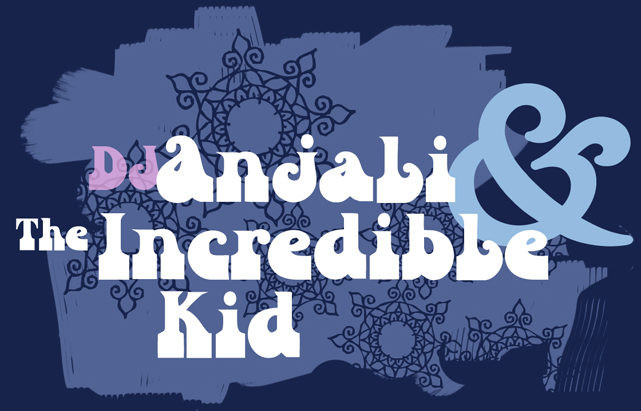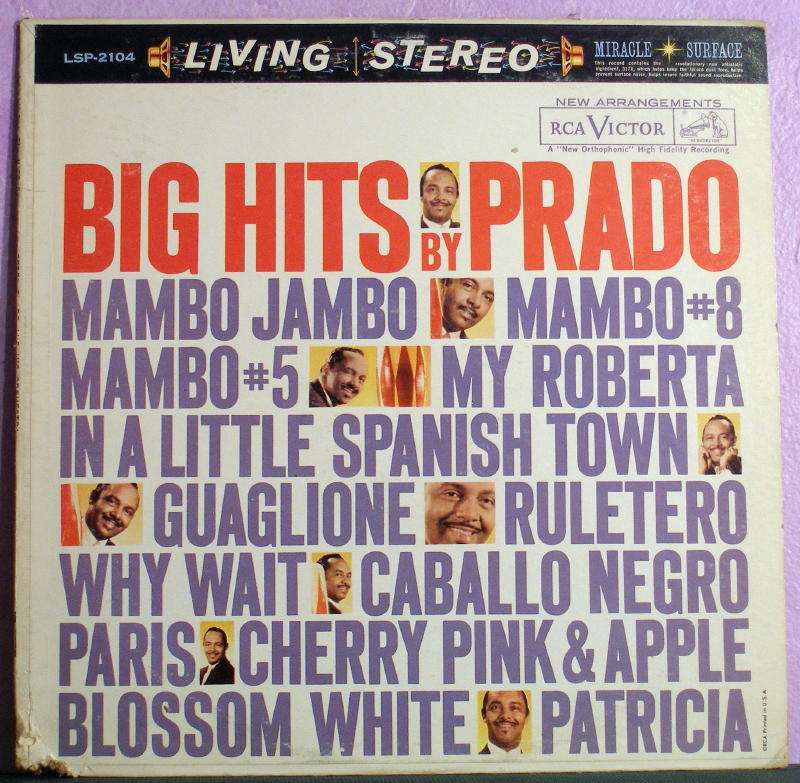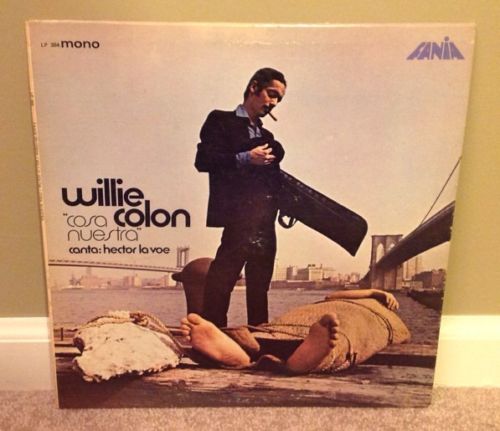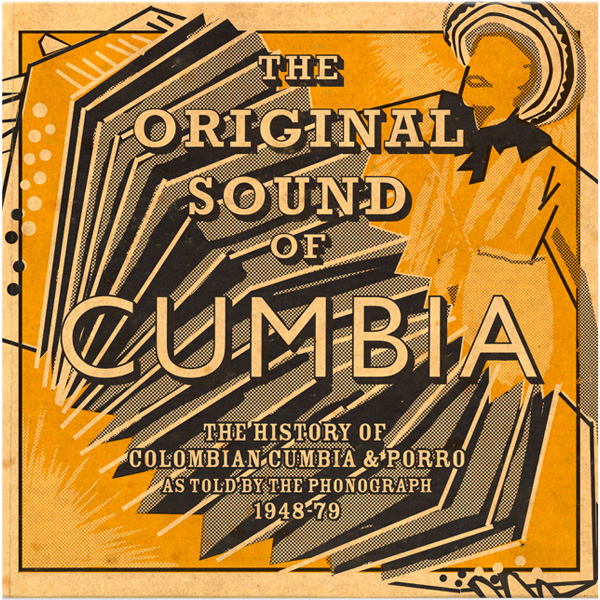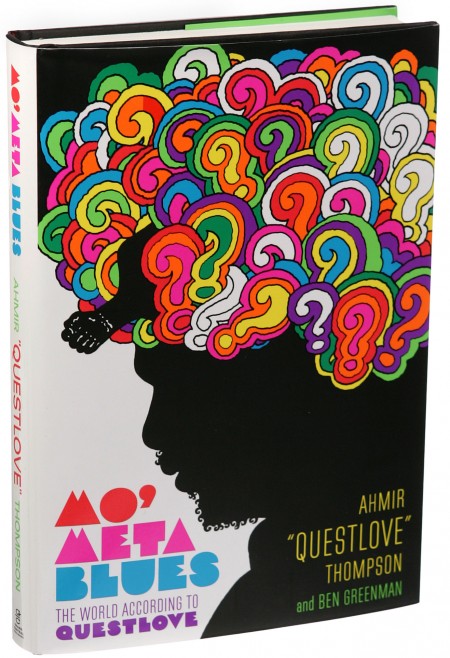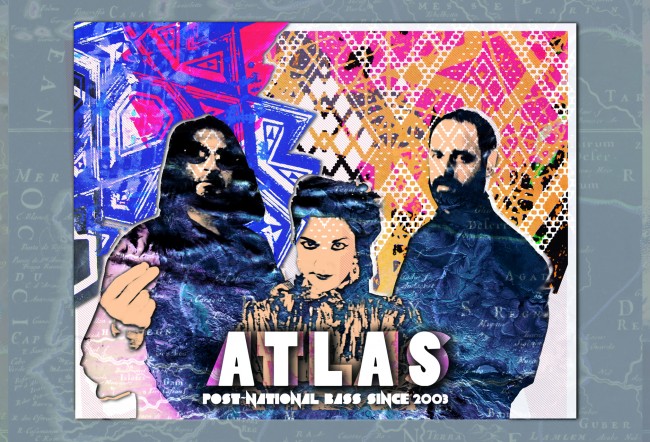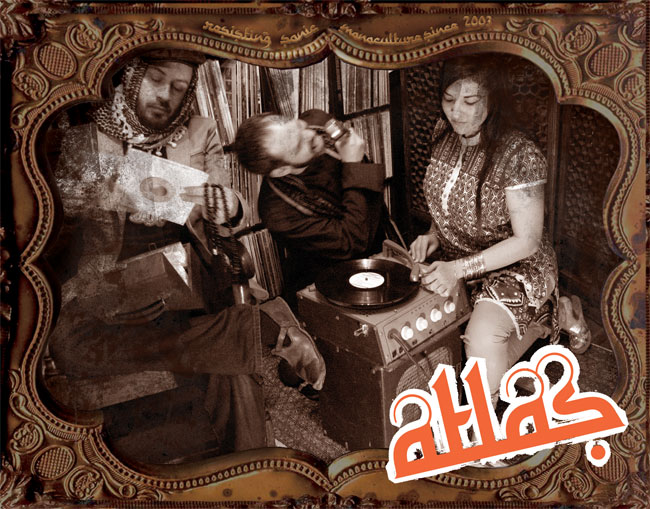Last year was the first year that Anjali and I had been asked to DJ NW music festivals outside of Portland or Vancouver, BC. First we DJed the Photosynthesis Festival in Randle, WA, and then the Beloved Festival in Tidewater, Oregon. Both were great experiences, and real highlights of a pretty miserable Summer for us. After playing for Portlanders for ten years we had started to feel like a lot of people were bored and done with us, and it was easy to feel boring and over, until we played for people who had never seen us before, and their fresh interest and enthusiasm were reinvigorating.
Our first festival this year was the Sasquatch! Festival at the Gorge Amphitheatre in George, Washington. I had not been to the Gorge Amphitheatre since the Summer of 1994 when my friend Jeremy Pinkham and I went to see Stereolab play at Lollapalooza. (We also saw them the night before in Seattle; I followed Stereolab quite a bit in the ’90s, and if you have only heard their recorded material, then you probably have no idea of what a fierce improv electronic noise act they could be on the road when they were feeling it.) Despite this being the ten-year anniversary of Sasquatch!, Anjali and I had never been before and weren’t sure quite what to expect. We were initially booked to open up the dance tent (Banana Shack) Saturday, Sunday, and Monday, with the thought that Anjali would offer some dance lessons, and we would be able to manage the transition from comedy acts during the day, to electronic dance acts at night. Adam Zacks, festival organizer, had attended Portland poster maven Mike King and costume designer & stylist to the stars Julia Bartholomew’s wedding the prior year, which we DJed, and after seeing us perform, with Anjali giving some bhangra lessons to the wedding guests during our DJing, he apparently thought we would be a good choice to open the dance tent. Then at the last minute, we were offered an additional three-and-a-half hour set on Friday opposite the Foo Fighters. Some people online were already talking a bunch of smack about us because we had been booked three times, when no other artist had been booked more than once. Being booked a fourth time, for a three-and-a-half-hour set at that, only riled them up all the more. Apparently people felt that our being booked multiple times was standing in the way of their favorite band getting booked. All the people saying horrible things about us clearly knew nothing about us and had never heard us, but the nastiness and resentment was unpleasant to witness. To top it all off, Anjali and I were the only performers at the festival who had never written a song, produced a song, performed on a song, remixed a song, released a record, etc. We just try to share great music with our dancers and suddenly here we were, the resident DJs of the Banana Shack for Sasquatch’s ten-year anniversary.
Because of all the online hatred, I wasn’t sure what kind of unpleasantness we would experience once we got to the festival. Would people yell at us, throw things at us, assault us? Would ignorant people think we were playing “Osama Bin Laden” music or some other such nonsense? (People often think we are playing Arabic/Middle-Eastern music when we are actually playing Indian music. We play Middle-Eastern music as well, but a lot of people can’t tell the difference.)
We were fortunate that our friend Jori Zan was willing to drive us up, and that Erika and Jasmine of Bridgetown Revue were going to be able to make the festival, and dance onstage during some of our sets.
We were excited to be offered the long DJ slot on the opening night, because as much as we love Panjabi music, we are often pigeonholed as not doing anything else, and Friday night gave us time to stretch out. We knew for the daily forty-five minute slots that Anjali was expected to give Panjabi dance lessons, and it wouldn’t make any sense, and would only confuse people, if we starting switching it up twenty minutes into our set. Since so many people at the festival would have never seen us before, Friday night gave us a chance to leave a completely unique first impression on whoever would show up to the Banana Shack.
It was great to have both the Portland Mercury and Oregon Music News give us positive press before the festival, to counter all the online hatred. It felt like a nice hometown send-off on our way to Washington. The Mercury even recommended us over the Foo Fighters and called us “local heroes.” When we arrived at the festival things were very disorganized. No one working the perimeter who we talked to seemed to know anything. All the first people we talked to were the very lowest workers in the hierarchy, didn’t have correct information, and often spoke very little English. It was funny, because the smaller-scale festivals that we have DJed seemed way more organized, and we thought such a giant operation as Sasquatch, celebrating its tenth anniversary no less, would be far more together. We had the experience of being sent from one place to another, only to go back to the first place because they didn’t give us what we needed. We were camping in the “artist” area, where we never met or saw any other artists.
We finally set up our tents, got situated, and headed to the Banana Shack for our lengthy set opposite the Foo Fighters. It was a long hike, many hundreds of yards, loaded down with our music, and a hike that was to be repeated many times, in both directions, throughout the festival. The Banana Shack was a giant tent that fit around a thousand people, with massive sound and lighting systems installed, and it sounded better to me than any other festival stage I listened to all weekend. We arrived well before our set and there were already hundreds of people sitting waiting in the tent. I was already stunned, because I had bought into the online hate that no one was coming to see us. The people that worked the Shack including Jess and Dan were super sweet, and everyone was a real joy to work with all weekend. When I went out onstage to start setting up DJ equipment well before our start time, a cheer erupted from the crowd which utterly shocked me. Who did they think I was? A superstar or something? By the time our start time came closer the tent was at capacity with all sorts of kids pressed up against the stage barricade like they were about to see their favorite rock stars or something. Hip-hop classics were being played over the soundsystem before the start of our set. They played Nas “Made You Look,” and I was like, “Shoot, I was thinking about playing that.” That is just the sort of thing I don’t normally play that I was looking forward to dropping in my set. Well, the DJ certainly has to step it up a level from the pre-show music, so so much for my playing Nas.
When they played Biz Markie’s “Just a Friend” the whole massive crowd was loudly singing along. I got very worried. I love Biz Markie as much as the next true-schooler, but I was afraid that if the crowd was so jazzed to hear hip-hop classics that they would hate the “foreign” shit I was about to drop on them. I hoped they weren’t going to crucify me, and I went out on stage. I started out with one of my favorites: Zion I’s “Geek to the Beat,” since I wanted to reach out to the hip-hop loving crowd, while also signalling my desire to bust out some traditional percussion. I then brought in the heavy dhols, and was happy to hear a roar of excitement erupt from the crowd. “Cool, they might just be up for this.” Anjali and I pretty much wing it every time we go out on stage. Sometimes we will have an idea of the first song we are going to play, sometimes not. All I remember is that in addition to bhangra I was mixing in some Funk Carioca and some hip-hop, including my Beastie Boys tribute, since they put on the best show when I went to Lollapalooza in the Gorge in 1994. I tried to break up the bhangra sets, just because I figured this crowd probably couldn’t take three-and-a-half hours of bhangra. I was very wary of playing any Latin music, including favorite genres of mine such as reggaeton and merengue urbano, sensing that the crowd wouldn’t be that appreciative, but I found myself mixing in Funk Carioca, which I don’t play that much of these days, sensing it might go over, and the cheers of approval when I brought in those tracks made me wonder how familiar some of the crowd might be with that music. I was very aware of not playing any Major Lazer, as they were closing out the festival in the Banana Shack, and I didn’t want to commit a festival faux pas by playing their music before their appearance. Major Lazer were the only act playing Sasquatch! whose music I have ever played out in my DJ sets. It is a testament to how much they have their finger on the pulse of what makes the kids dance these days that I had to keep myself from playing them.
Despite many post-show writeups to the contrary, other than one song, we weren’t playing Bollywood House. I only played one Bollywood (and not House-y) song all night, “Chinka Dhika,” (the Hindi cover of the Telugu “Ringa Ringa”). Anjali did play Bollywood House track “Fully Faltu,” which was the only Bollywood House song we played all weekend. She introduced the song by asking the crowd if they wanted to “hear any Bollywood,” to which hundreds of people screamed, “YEAH!” Other than a few Bollywood samples, we only played three Bollywood songs in the more than eight hours we DJed at the festival over four days. Yet, so many festival writeups I have read claim we played Bollywood all weekend. In fact, Anjali began her first set Friday night with a lot of tracks featuring dancehall vocalists over heavy European club beats, but you won’t find any references to that in reviews of our performance.


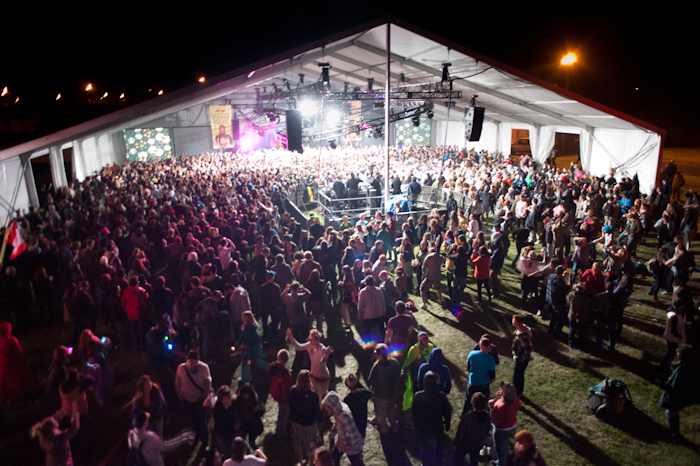
I have played to 500+ people on many occasions, but Friday night was easily the largest crowd I had ever been in front of. Bodies stretched out far into the horizon. Everyone having it. Kids pressed up against the rail. Most of the time the Fog Machine was so intense, that along with the manic lights, I could mostly only see the first couple rows of people. Unfortunately the fog machine gave me a nasal drip, so I kept wiping my nose the entire time I was on stage, which you can clearly see in one of the youtube videos that has been uploaded of our performance. (Which is titled DJ Anjali, even though I am the only one DJing in the video.).
The crowd was so incredibly hyped, possibly beyond that of any crowd that I have ever played for before, that cheers would arise spontaneously whenever there was any sort of breakdown, or lull, or buildup in a song. Loud, loud, thunderous cheering. Over and over. I wasn’t sure how much people were going to be open to bhangra, but whenever I brought in a dhol roll, or a tumbi lick, that same thunderous cheering would return. I really wanted to force some SOUTH Indian beats on the crowd, which I knew would be pushing them really far, but playing that music was the most personally exciting direction for me, and I managed to squeeze in a Tamil, a Telugu, and a Hindi Telugu Cover, without clearing the tent, so mission accomplished. Halfway through our set the production staff were so blown away by how many kids were packing in to the tent to see us that they asked us if we would be willing to add some last-minute late-night sets to the three additional early everning sets we were already scheduled to play. Of course we said yes, and relayed the news to the dancing throngs who cheered appreciatively. At one point in my second set I was mixing global house beats, and people seemed to be responding so well to the house set that I realized I could probably play house quite successfuly for the rest of my set, but that just wouldn’t be me, so I had to switch it up, and bring in some more bhangra and political hip-hop. I dropped dead prez’s “Hip-Hop” at one point, and during the repeating phrase of “hip-hop” in the chorus I slowly brought down the volume, and there was a magical moment where the crowd began to hear themselves and I felt the thrill of their self-realization, as the crowd registered how much they were all chanting along with the song. A perfect, unscripted moment. Anjali played the last set of the evening, and she brought in some grime, some desi dubstep, bassline, and Asian R&B, among many other sounds, in a desi-focused, but still highly diverse set. The crowd responded well to the dubstep, but to my eyes it seems like they got off the most when she brought in a house beat. Towards the end of her set Anjali decided to bring in some context for the crowd, playing “Mundian To Bach Ke” and Truth Hurts’ “Addictive,” choices that both really surprised me.

Erika and Jasmine arrived from Portland in time to perform a captivating sword dance and more during Anjali’s second set.
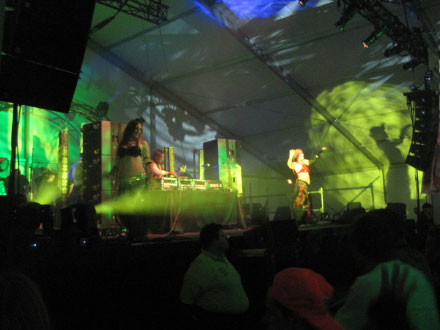
There was talk of our set being extended past 12:30am, since there were still so many people in the tent dancing, but the head of production couldn’t be reached by radio, so we shut down at the scheduled time only to be faced with a mob of kids pressed up front chanting, “One more song!” Absolutely riotous reception. Crazy beyond my wildest dreams. Anjali was at the barricade greeting fans, and we both ended up signing a young fan’s Blazers jersey before we were back at our campsite. (My handwriting was even shakier and more appalling than my typical chicken scratch, so my apologies if I ruined your jersey, Malcolm.) My typical response is to hug the background while Anjali soaks up all the love, but I felt like, why not, I was onstage and they loved me too, so why shouldn’t I join in and soak up some adulation. I gave a couple high fives, and as we turned to go, I heard someone shout behind me to come back, and when I did, I was told, “Not you.” Even at such an ecstatically well-received gig my second banana status remains unchanged. I told Erika and Jasmine about my desire to wear a yellow “Second Banana” T-shirt, and they said they would make me one. Crafty and creative ladies.
We were really concerned about how the first night was going to go, because if our first set wasn’t received well, then we would still have to perform the next three days and walk around the festival hanging our heads in shame, potentially mocked by thousands of pissed-off punters. As it was, people were so friendly and complimentary throughout the weekend, consistently surprised that we wandered around with the masses, because apparently most performers hide out backstage for the duration of their stay.
It was cool to be at the festival Friday, because as we quickly learned first thing Saturday morning, the security apparatus of the festival was barely operating Friday night, enabling us to walk around everywhere behind the scenes, encountering only one casual security guard in the mainstage area after having wandered everywhere else unmolested. He was totally cool with us hanging out after discovering that we were artists, but by the next day no one was allowed into the highly-restricted mainstage backstage area without a separate mainstage wristband above and beyond the allegedly all-access wristbands we already wore.
We were so lucky to be performing every day because that meant we got a chance to get friendly with the really great staff, and get a sense of the festival as a whole, rather than just a single day. Mercifully the music ended before 1am each night and didn’t start up again until around noon, which seemed quite humane compared to other festivals where ear plugs offer no defense, as dubstep rattles the ground your tent is staked to at 4am, 6am, 8am,10am, etc. Still, there was enough noise of people celebrating and drunken wanderers that I spent several hours awake in the tent each night, as well as getting up far earlier than I would normally, because of the early bright desert sun. Our “artist” camping area was fairly quiet, and all weekend I kept hearing what a zoo general camping was, and in the hours just after the festival music ended I would hear what sounded like the roaring cheers of thousands in the distance, a distance I assumed was the general camping area, and I wondered if there were spontaneous performances over there, or some other happenings that encouraged such excitement.
The catering for the artists was really top-notch, and I looked forward to the buffet-style meals for lunch and dinner each day. I am a vegetarian who occasionally eats seafood, and in addition to plentiful vegan and vegetarian options, there was really well-prepared salmon served at many meals, which is quite a testament to the quality of the catering, as I have DJed many weddings with awfully cooked salmon. There was usually at least one, if not several, very spicy dishes at the meals which really impressed me. I love spicy food, and some of these dishes even had a kick for me, so congratulations to the cooks. I had only recently been introduced to Molly Moon’s Ice Cream in Seattle by my sister, and there was a free truck set up for artists in the backstage area. In one day I managed to make my way through most of the menu, which is good, because my desire for ice cream, and my siting of the truck never matched up again for the rest of the weekend. There was also a truck with Ben and Jerry’s offerings and that truck and Molly Moon’s switched places every day. It says a lot about my fresh excitement for Molly Moon’s that hardcore Ben and Jerry’s addict that I am, I was always disappointed when it wasn’t the Molly Moon’s truck within arm’s reach.
There was also a dollar-a-minute massage tent, which I took advantage of several times, as my neck and shoulders were incredibly sore from long walks lugging heavy, akward DJ bags, and sleeping on the ground every night.
Having had such a phenomenal response on our opening night it remained to be seen if we could pull the feat off again on Saturday, this time in the early evening. We now also had an additional forty-five minute late-night set between Sleigh Bells and Bassnectar on Saturday. Miraculously, even after having played three-and-a-half hours the night before, the tent completely filled up and overspilled again for our first early shift. People were loving it. Amazing. I forced Anjali to DJ one song, but she really didn’t want to have to DJ, as we were contractually obligated to provide Panjabi folk dance lessons at the early sets, and she didn’t want to have to teach dance lessons and DJ both in a mere forty-five minutes. The lesson was very well-received, the crowd incredibly loving and demonstrative, and we chalked up another success. The crowd was so raging, and so nuts, and so jumping up and down, that I cockily thought that the Glitch Mob going up next would have a hard time following us. Yeah, right. I had immediately noticed Edit earlier in the day in the backstage tent, greased pompadour and black leather jacket, looking very L.A. and very not-Sasquatch. He oozed attitude, and I didn’t end up interacting with him until after their set. The Glitch Mob had a very polished presentation, and they knew exactly what they were doing, slowly building the crowd’s energy with their glitchy beats and live drumming until they had everyone in a frenzy. As much as I thought Anjali and I had packed them in, far more people showed up for the Glitch Mob, and clustered in dense mobs all around the rolled-up side flaps of the tent, and clogged up the area behind the tent in far thicker numbers than even we had managed. Their stunning piece-de-resistance was bringing out a drop-dead-gorgeous lingerie-bedecked aerialist for their final song. Anjali and I both thought she was Desi, bindi and everything, but she said she was half-Chinese and half-Irish. Apparently she was ill; I noticed her spend the whole day sleeping in the backstage tent before their performance. She was supposed to go on twice during their set, but could only manage the one song. You couldn’t tell her condition from her performance; again and again she climbed dozens of feet to the top of her silk aerial ribbons, wrapped herself into knots, and then fell rapidly to the ground, unraveling from her ribbons, and stopping short of the stage, splayed into the splits or other startling poses. How do you top an aerialist? I was blown away. After the show Edit was so completely sweet and unassuming, that I realized that people who seemingly have tons of attitude can be completely chill and down-to-earth. Apparently everything that could have gone wrong technically with their set did, and their entire lighting set up refused to turn on. Despite their concerns they totally came through and blew away the throngs.
Sleigh Bells were up next, and their album is one of the few “rock” releases I have bought in more than a decade, so I was curious to see their show. They seemed very reticent to go on, and it seemed like they might be stressed out to go on after a very well-received Glitch Mob. Their set start time was very delayed, there was lots of tension backstage, and people were running around with frantic expressions. Apparently their lighting setup wasn’t working either, but the Banana Shack came equipped with such a massive lighting system that the production staff just wanted them to get out there and do their thing. Despite their seeming reluctance to go on, the crowd went nuts. Their combination of guitar noise and pounding hip-hop beats was my personal favorite sound of all the non-DJ Anjali and The Incredible Kid artists playing all weekend that I heard. More than any other artists I kept hearing people bring them up in conversation about how much they slayed during their appearance at the festival. I was sidestage for most of their set, so I didn’t really “see” their performance, but I heard it, and those heavy, heavy beats shot through with guitar noise sounded great.
Anjali went on after Sleigh Bells, but there was no announcement, the stage turnover took awhile, and by the time she was playing, there was only twenty minutes or so before Bassnectar was to begin performing over at the Bigfoot Stage, where there were already thousands of people pressed in awating the start of his set. We had announced our last-minute-addition late-night set from the stage during our early slot, but that was the only publicity that our later appearance received. I was bummed when there were only around 600 (according to Jess) people to see Anjali, but given that there was so little notice given, I should be thrilled that our lightest crowd of the weekend was still so large, especially as I saw many artists that had far, far less people present to see their only appearances at Sasquatch. Erika and Jasmine of the Bridgetown Revue performed with Anjali, and she took a left-turn from our other appearances playing Israeli and Balkan sounds for her dancers. Since there were no dead spaces in the late-night schedules for Sunday and Monday, that was to be our last late-night performance of the festival, which was for the best, as playing unannounced sets left a little something to be desired. I wandered over to Bassnectar’s set, but no matter how many people were packed in to seem him, I was bored and left before long. He played a Nirvana and a Zeppelin remix, and I was hoping for far more interesting sounds. He was actually playing more drum’n’bass than dubstep during the part of his set that I witnessed, which surprised me. Anjali and I had been dropping some drum’n’bass in our Friday night set, and I thought the kids would have all moved on to newer sounds, but we weren’t alone in favoring those sounds apparently. On our way back to camp I even heard a Britney remix. Reallly? (Edit: Turns out this was a Dev and the Cataracs remix, but at the time I thought it was Britney.) And people were so excited for his set.
Sunday morning we said goodbye to Erica and Jasmine, and Erica’s daughter Cody, who was our delightful companion, and our posse got a lot smaller and less family-like. Even though I was sleeping a little better on the ground each night, I was still getting far less sleep than I needed, and I was steadily getting more and more bedraggled. Despite hours spent lying on the backstage couches each day, I couldn’t sleep, as there was far too much noise at the festival, and I have never had much luck tuning out music in order to sleep. The Banana Shack staff was happy to have us go on early, so we played for about forty minutes before our scheduled start time, giving us
a rare opportunity to play for a smaller group of dancers wandering through the area, and a chance to sharpen up on stage before the throngs would arrive. Sunday’s appearance was particularly packed, and many people said our fourth appearance was the best of the lot. It was even more special, because Mike King, Julia Bartholomew and Connie Wohn who all played a role in our Sasquatch booking were backstage to witness the epicness. (Thanks for the photos, Connie!)



Several of our friends who aren’t even fans of our music were highly complimentary of our performance, and how much we got the crowd going. DJ Aanshul from Seattle was in attendance, and it was a surprise for both of us, as he wasn’t even initially aware of our appearance at Sasquatch! when he decided to go for the day. It was great to catch up and hear some inside news on the Seattle Desi scene. Seems like there are some serious scores to be settled, and I got a little hyped up about wanting to get in on the payback. Booyah! Aanshul was highly complimentary, and that meant a lot, as he is a one of the most technically-skilled DJs in the Desi scene. We were actually the first people to bring Aanshul to Portland, to play at our first Bollywood Horror Halloween costume party back in 2003.
MSTRKRFT packed them in. Thousands and thousands of kids losing it in all directions. I was bored, but such is life.
By Monday I was so drained and useless, and really worried about being able to do it all again for yet another day. I was very aware that every other artist at the festival had to come out and do their thing and wow the crowd only once. We were going to have to do it for a fifth time. It was clear that many people were returning to see us day after day, so I was trying to repeat as few songs as possible, and really keep it fresh. Anjali was getting sorer and sorer each day, and for several days she would tell me before our performance that she was only going to dance to one or two songs, and then she would be out there giving it her all for nearly our entire performance slot. She seemed so wasted Monday that she was very convincing when she told me she was only going to do one song tops. I went on an hour early, and played for a tiny group of dancers, even losing some when I went on a pet South Indian film song spree, but the tent slowly filled up by the time our scheduled start time arrived. I was hoping that our fifth and final appearance would be the most rammed of the entire weekend, just to cap everything off, but the tent was only mostly, not entirely, full, and there weren’t the masses swirling around the edges of the tent either. Still, we had a full house for our fifth appearance at the festival, and what better riposte to all the haters who said we weren’t even going to manage to get people to see us even once. People were stoked, loud, bouncey, and demonstrative, and I therapeutically engaged them in a mass shout-along screaming “Fuck the haters!” to exorcise the bitter online frothings I had witnessed. It was a love fest, and a beautiful end to our performance schedule. People knew Anjali’s routines to such an extent that they were holding up five fingers in advance of her talking about the five rivers flowing through the Punjab. We heard from many people who came to see us all five times, and that felt, really, really good, especially when they said we kept it fresh and they didn’t get bored.
Bonobo was on next, and he was incredibly sweet and complimentary. I told him that I had read at the time about his playing “Mundian To Bach Ke” in his sets back before it hit the mainstream, and he agreed that he had, but admitted that he didn’t really keep up with Desi beats. He left a great personal impression, but because of limited catering dinner hours we decamped to the food tent, and Skrillex was on when we got back to the Banana Shack. I was not even aware of having heard a Skrillex song before, but the thousands of kids going insane to his set were screaming along to the words, and seemed to know every vocal sample in his songs backwards and forwards. He worked and worked and worked the crowd, and I wondered if there would be any energy left for when Major Lazer went on. Hanging out with Major Lazer backstage: sounds like it would be epic, right? Pretty mellow, although it was a little surreal to be using a urinal next to Skerrit Boy in the backstage bathroom trailer, especially as I had foreseen that happening earlier in the day. Major Lazer took over after Skrillex. Having seen them before, I felt pretty confident that I wasn’t going to be surprised by anything in their set. They had a new, far less Amazonian and leonine female dancer than the prior one we had seen. Their new female dancer was very young and incredibly thick. Most of her moves seemed to involve floor poses, which only the first few rows could see, unless the crowd were watching the video screens. We stayed for their whole set, despite a five-hour drive back to Portland ahead of us that night. I really liked the “new song” they teased us with at the end. Jori took the first driving shift, and before long we realized we were all far too wiped to drive, so we pulled over and slept for hours on the side of the road. Anjali is terrified of my driving, and so she and Jori took turns chugging caffeinated beverages and driving while I slept in the backseat. We made it back to Portland around 6:30am Tuesday morning.
Well, we were completely wiped and exhausted, but we did it. Almost eight hours of performances over five appearances in four days. No one else at the festival even came close. We made tons of new fans and soaked up so much love and enthusiasm. We gained three-hundred some fans on our newly-created facebook page within 24 hours of the end of the festival, and were the beaming recipients of dozens of complimentary messages. We received waves and waves of praise that made every bit of adulation we had received in the decade prior seem to pale in comparison. Was this the peak of a long career, or the stepping-stone to a new and brighter future? Well, the booking requests and interview requests have been coming in. We will be playing No.Fest, Photosynthesis, Beloved, Decibel, Musicfest NW and are lining up gigs in Vancouver and Bellingham, so things are looking pretty good. Thanks to everyone for all the love and support.
IK
